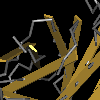?cl02559: GPS Superfamily (this model, PSSM-Id:295363 is obsolete and has been replaced by 470616)
 
GPCR proteolysis site, GPS, motif The GPS motif is found in GPCRs, and is the site for auto-proteolysis, so is thus named, GPS. The GPS motif is a conserved sequence of ~40 amino acids containing canonical cysteine and tryptophan residues, and is the most highly conserved part of the domain. In most, if not all, cell-adhesion GPCRs these undergo autoproteolysis in the GPS between a conserved aliphatic residue (usually a leucine) and a threonine, serine, or cysteine residue. In higher eukaryotes this motif is found embedded in the C-terminal beta-stranded part of a GAIN domain - GPCR-Autoproteolysis INducing (GAIN). The GAIN-GPS domain adopts a fold in which the GPS motif, at the C-terminus, forms five beta-strands that are tightly integrated into the overall GAIN domain. The GPS motif, evolutionarily conserved from tetrahymena to mammals, is the only extracellular domain shared by all human cell-adhesion GPCRs and PKD proteins, and is the locus of multiple human disease mutations. The GAIN-GPS domain is both necessary and sufficient functionally for autoproteolysis, suggesting an autoproteolytic mechanism whereby the overall GAIN domain fine-tunes the chemical environment in the GPS to catalyze peptide bond hydrolysis. In the cell-adhesion GPCRs and PKD proteins, the GPS motif is always located at the end of their long N-terminal extracellular regions, immediately before the first transmembrane helix of the respective protein. |
